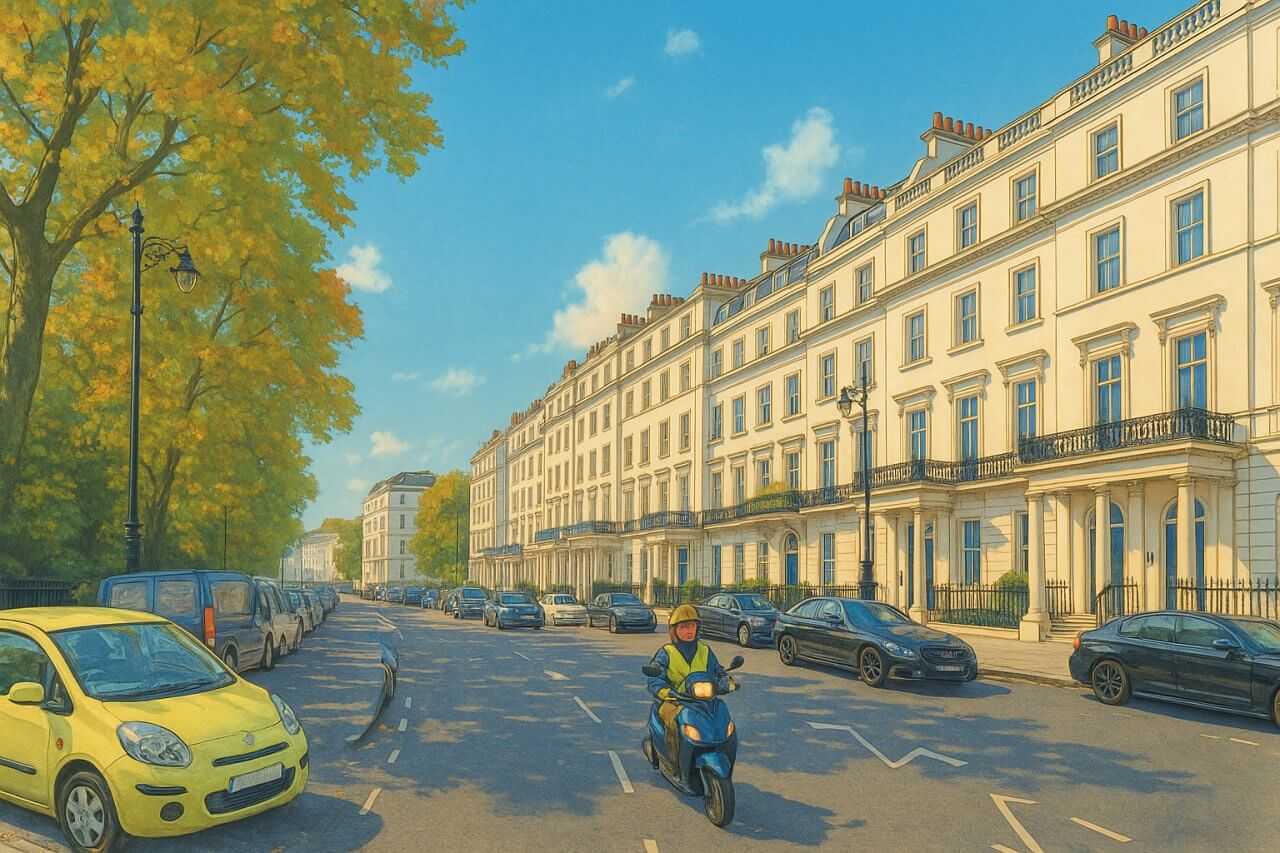
Belgrave Square, London
Belgrave Square is one of London's grandest and most prestigious garden squares, located in the heart of Belgravia, within the City of Westminster. It refers not only to the formal square and its central private garden but also to the roads encircling it, which include Grosvenor Crescent, Halkin Street, Chapel Street, Upper Belgrave Street, Belgrave Place, Chesham Place, West Halkin Street, and Wilton Terrace.
Overview and Road Layout
The square functions as a large roundabout, with traffic flowing clockwise in a one-way system around its perimeter. Several connecting roads, including Upper Belgrave Street and Halkin Street, feed into the square and extend further into Belgravia and Knightsbridge. The square measures approximately 650 feet (about 198 metres) across, making it one of the larger formal squares in Central London.
History of Belgrave Square
Belgrave Square was laid out in the 1820s as part of the grand design of Thomas Cubitt, a master builder responsible for much of Belgravia. Construction began in 1826, commissioned by Richard Grosvenor, the 2nd Marquess of Westminster, as part of the Grosvenor Estate development. The buildings surrounding the square were completed in the 1840s and were designed in the Neoclassical style by architect George Basevi.
The square was intended from its inception to house the aristocracy and the wealthy elite of London, and over the decades it has served as home to dukes, foreign ambassadors, and international businesspeople.
Name and Pronunciation
The name Belgrave Square is derived from the village of Belgrave in Cheshire, near the Grosvenor family seat, Eaton Hall. The name was selected by the Grosvenor family to honour their ancestral lands. The pronunciation is "BEL-grayv", with the phonetic spelling: /ˈbɛl.ɡreɪv/. 
Character and Ambience
Belgrave Square is one of the most exclusive and elegant squares in London, known for its stately white stucco terraces, tall sash windows, classical columns, and decorative ironwork. The square has an atmosphere of refined calm, with its leafy garden at the centre accessible only to keyholders, surrounded by buildings now largely occupied by embassies and private clubs.
Despite its central location, the square remains relatively quiet, providing a peaceful retreat from the bustle of nearby Knightsbridge and Hyde Park Corner.
Streets connected to Belgrave Square
- Belgrave Place
- Chapel Street
- Chesham Place
- Halkin Street
- Grosvenor Crescent
- Upper Belgrave Street
- West Halkin Street
- Wilton Terrace
Points of Interest
- Embassies: Several grand buildings around the square house embassies, including those of Germany, Spain, Norway, and Portugal.
- Statues and Monuments: The garden contains several notable statues, including those of Simon Bolívar, Christopher Columbus, and Prince Henry the Navigator.
- British-German Association: Located at No. 34, this is an important institution fostering Anglo-German relations.
- Former Residences: The square was once home to famed Prime Minister Stanley Baldwin and financier Alfred Beit.
Real Estate and Property Values
As of early 2025, Belgrave Square remains among the priciest residential locations in London. Properties around the square are typically grand five- to six-storey townhouses, with interiors ranging from approximately 7,000 to 12,000 sq ft (650 to 1,115 sq metres). Prices range between £30 million to £60 million for entire homes, though some buildings have been subdivided into luxurious flats and embassies.
Compared to most parts of London, Belgrave Square is in the top 0.1% of property values, even within Belgravia itself. The square's location, architectural quality, and diplomatic associations contribute to its exclusivity.
Transport Connections
London Underground
The nearest London Underground stations are:
- Hyde Park Corner (Piccadilly Line) – approx. 5-minute walk north.
- Victoria Station (Victoria, District, and Circle Lines) – approx. 10-minute walk southeast.
- Knightsbridge Station (Piccadilly Line) – approx. 10-minute walk west.
Bus Stops
Several bus routes serve the area via nearby Grosvenor Place, Hyde Park Corner, and Buckingham Palace Road. These include:
- Bus routes 2, 16, 36, 38, 52, 73, and 390, providing connections to Oxford Street, Marble Arch, and Victoria.
Fun Fact
One of the most unusual and endearing facts about Belgrave Square is that it has hosted numerous cultural statues representing the nations whose embassies line the square. These include not only Columbus and Bolívar but also a bronze bust of the Portuguese poet Luís de Camões. Together, they give the garden an international flair that reflects the square’s global diplomatic role.
Quick Facts
- Location: Belgravia, City of Westminster, London
- Surrounding Roads: Grosvenor Crescent, Halkin Street, Chapel Street, Upper Belgrave Street, Belgrave Place, Chesham Place, West Halkin Street, Wilton Terrace
- Traffic: One-way clockwise around the square
- Construction: Began in 1826 by Thomas Cubitt
- Architectural Style: Neoclassical white stucco townhouses
- Name Origin: From Belgrave, Cheshire (pronounced "BEL-grayv" /ˈbɛl.ɡreɪv/)
- Character: Quiet, diplomatic, exclusive
- Embassies: Germany, Spain, Norway, Portugal (among others)
- Real Estate Prices: £30–60 million for houses (as of 2025); approx. 7,000–12,000 sq ft (650–1,115 sq m)
- Nearest Tube Stations: Hyde Park Corner (Piccadilly), Victoria (Victoria, District, Circle), Knightsbridge (Piccadilly)
- Nearby Bus Stops: Grosvenor Place, Hyde Park Corner, Buckingham Palace Road
- Fun Fact: The square features statues of global historical figures, giving the garden an international character
Who Were the Grosvenors, and How Did They Acquire This Land?
If you're wondering why so many streets and squares in this area bear names like Grosvenor, Belgrave, Eaton, or Wilton, it's because much of this land once belonged to the powerful Grosvenor family. To find out how they came to own vast swathes of Mayfair, Belgravia, and Pimlico — and whether they had any ties to the government or the royal family — read our in-depth article here.
Map of Belgrave Square, London

Painting of Belgrave Square, London (View image in full size)